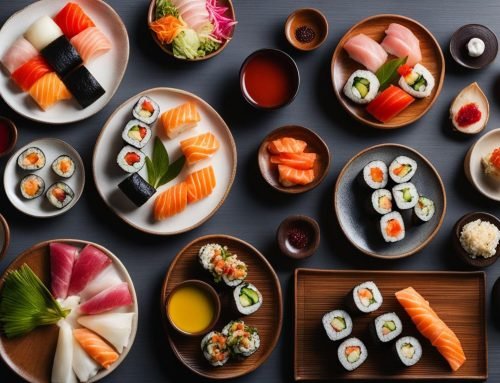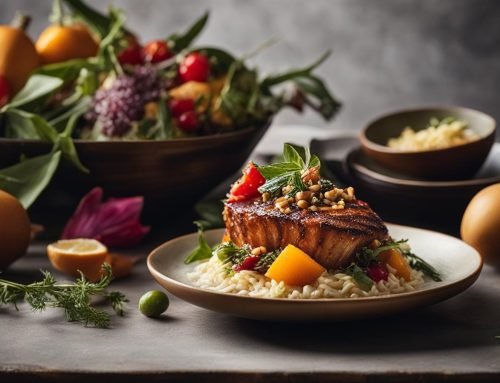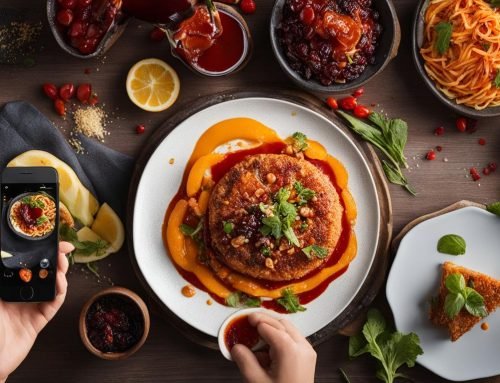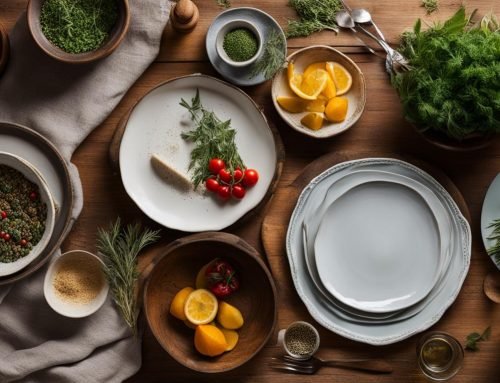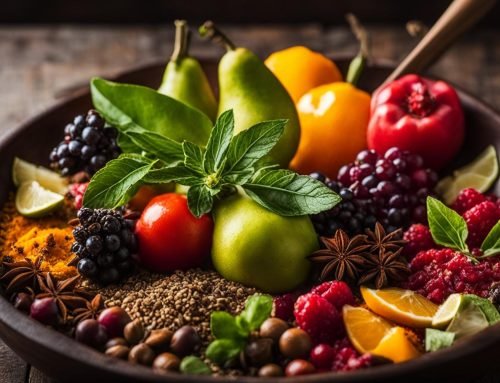
Regarding food photography, having the right equipment can make a big difference in the quality of your shots. From cameras and lenses to lighting and props, there are several key items that every food photographer should consider investing in. In this article, we will explore the essential food photography equipment to help you enhance your shots and take your culinary captures to the next level.
Key Takeaways:
- Investing in the right food photography equipment is crucial for capturing stunning culinary shots.
- Cameras, lenses, lighting, and styling tools are essential equipment for food photography.
- Popular camera options for food photography include the Canon 6D Mark II and the Nikon D850.
- Choose lenses that can effectively capture details, colors, and depth, such as the Canon 100mm F/2.8L macro lens.
- Good natural and artificial lighting sets the mood and highlights the details in food photography.
Camera: The Photographer Makes the Photo
The camera is where it all starts for food photographers. While the photographer’s skills are the most crucial factor, having a reliable camera can help you capture the details and colors of your food in the best possible way.
“Having a high-quality camera is essential for food photography. It allows you to capture the textures, colors, and intricate details of your dishes with precision.”
Some popular options for food photography include the Canon 6D Mark II, an entry-level full-frame camera, and the Nikon D850, known for its high resolution and excellent image quality. It’s important to choose a camera that suits your needs and budget, as well as one that you are comfortable using. Different cameras have different features and capabilities, so it’s important to do some research and read reviews before making a purchase.
Lenses: Capture the Details and Depth
In addition to a camera, lenses play a crucial role in food photography. The right lens can help you capture the details, colors, and depth of your food more precisely.
“Investing in a good set of lenses is just as important as investing in a good camera. Lenses with wide apertures allow you to achieve a shallow depth of field, creating a beautiful bokeh effect that makes your subject stand out.”
The Canon 100mm F/2.8L macro lens is popular among food photographers for its versatility and ability to capture sharp close-up shots. A 35mm lens is recommended for cropped sensor cameras, while a 50mm lens is an excellent option for full-frame cameras. Consider the focal length and aperture when choosing lenses, as they will greatly impact the look and feel of your food photographs.
Stay tuned for the next section, where we’ll explore the importance of lighting in food photography.
Lenses: Capture the Details and Depth
In addition to a camera, lenses play a crucial role in food photography. The right lens can help you capture the details, colors, and depth of your food in a more precise way.
The Canon 100mm F/2.8L macro lens is a popular choice among food photographers. This versatile lens lets you get up close and personal with your subject, capturing sharp close-up shots that showcase the intricate details of your food.
If you’re using a cropped sensor camera, a 35mm lens is recommended. This lens provides a wider field of view, allowing you to capture more of the scene while still maintaining sharpness and detail. On the other hand, if you’re using a full-frame camera, a 50mm lens is a great option. It offers a natural perspective that closely resembles what the human eye sees, making it ideal for capturing food in a visually appealing way.
When choosing lenses for food photography, consider focal length, aperture, and image stabilization. Experiment with different lenses to find the ones that best suit your style and the type of shots you want to capture.
Lighting: Set the Mood and Highlight the Details
When it comes to food photography, lighting is a crucial element that can make or break your shots. It helps set the mood, highlight the details, and create a captivating atmosphere for your culinary creations. While natural light is often preferred, there are times when it may not be available or sufficient. In such cases, artificial lighting can come to the rescue.
Continuous LED lights and speedlights are popular choices among food photographers. Constant LED lights provide a steady and consistent illumination source, allowing you more control over the lighting conditions. They are especially useful when shooting in low-light environments or when you need to create a specific ambiance.
“Good lighting can transform an ordinary dish into a mouthwatering masterpiece.”
— Food Photography Pro
Speedlights, on the other hand, are portable and versatile. They can be easily mounted on your camera or positioned off-camera to create different lighting effects. They are ideal for capturing action shots or when you need to freeze motion while maintaining proper exposure.
Controlling the Light
Manipulating the lighting is another important aspect of food photography. You can use diffusers to soften the harsh shadows and reduce the contrast to create a soft and diffused light. This helps create a more pleasing and natural-looking image.
On the other hand, if you want to add more depth and dimension to your shots, reflectors can be used to bounce light back onto the subject. They can help fill in the shadows and create a more balanced lighting setup.
By experimenting with different lighting techniques and equipment, you can elevate your food photography and bring out the best in your food creations.
Tripod: Stability for Sharper Shots
When it comes to food photography, stability is key to capturing sharp and professional-looking shots. That’s where a tripod becomes an essential tool in your food photography equipment arsenal. A tripod provides the necessary stability to eliminate camera shake, resulting in clearer and sharper images.
With a tripod, you can set up your shot precisely and experiment with different angles without the worry of shaky hands affecting the outcome. This is particularly important when shooting in low light conditions or when using longer exposure times, as even the slightest movement can result in blurred images.
When choosing a tripod for food photography, consider factors such as height, stability, and ease of use. Look for an adjustable and sturdy tripod to hold your camera and lens without wobbling. Additionally, a tripod with a 90-degree center column can be beneficial for shooting overhead shots, allowing you to capture stunning flat-lay images of your culinary creations.
Styling Tools: Add the Finishing Touches
Regarding food photography, styling tools are essential for adding those final touches that make your food photographs truly captivating. With the right tools, you can enhance your culinary creations’ composition, presentation, and overall visual appeal. Here are some must-have styling tools that can take your food photography to the next level:
“Tweezers can be used to delicately place garnishes and adjust elements, ensuring everything looks perfectly arranged and visually appealing.”
- Tweezers: Tweezers can be used to delicately place garnishes and adjust elements, ensuring everything looks perfectly arranged and visually appealing.
- Pipettes: These small droppers are perfect for strategically placing drips of sauces and dressings, adding a touch of artistic flair to your food photographs.
- Squeeze and spray bottles: These tools allow you to create the perfect drizzle, giving your dishes a professional and polished look. They are also great for piping intricate details and adding decorative elements.
- Paint brushes: Whether you want to add a tiny bit of sauce or dressing exactly where it needs to be or create artistic strokes on your plate, paint brushes are versatile tools that offer precision and control.
By having these styling tools in your arsenal, you can experiment with different compositions, enhance the visual appeal of your dishes, and showcase your culinary creations in the best possible light. Remember, food photography is not just about capturing the taste and textures of the food, but also about creating visually stunning images that entice and engage the viewer.
Conclusion
Investing in the right food photography equipment is essential for capturing stunning culinary shots. Each piece of equipment, from cameras and lenses to lighting and styling tools, plays a crucial role in creating high-quality food photographs. By carefully selecting the best food photography equipment for your specific needs and budget, you can elevate your skills and take your shots to the next level.
Remember that your chosen camera is the foundation of your food photography journey. Consider options like the Canon 6D Mark II or the Nikon D850, which are known for their reliability and image quality. Pairing your camera with the right lenses, such as the Canon 100mm F/2.8L macro lens or a 35mm lens for cropped sensor cameras, will allow you to capture the details and depth of your food with precision.
Lighting is another crucial aspect of food photography. While natural light is preferred, artificial lighting sources like continuous LED lights or speedlights can be used when needed. Experiment with diffusers and reflectors to control and manipulate the lighting, enhancing the mood and highlighting the details of your food.
Lastly, don’t overlook the importance of a tripod and food styling tools. A tripod provides stability for sharper shots and allows you to experiment with different angles. Styling tools such as tweezers, pipettes, squeeze bottles, and paint brushes add the finishing touches to your compositions, giving you more control over the presentation of your food.
With the best food photography equipment at your disposal, coupled with practice and experimentation, you can develop your unique style and capture breathtaking food photographs. So, invest wisely, embrace creativity, and watch your culinary captures come to life!
FAQ
What are the essential food photography equipment items I should invest in?
The essential food photography equipment items to consider investing in include a camera, lenses, lighting, a tripod, and food styling tools.
What are some popular camera options for food photography?
Popular camera options for food photography include the Canon 6D Mark II and the Nikon D850.
What role do lenses play in food photography?
Lenses help capture the details, colors, and depth of your food in a more precise way.
What types of lighting are suitable for food photography?
Natural light is often preferred, but artificial lighting such as continuous LED lights or speedlights can also be used.
Why should I use a tripod for food photography?
Using a tripod provides stability, ensures sharp shots free from camera shake, and allows for precise positioning and experimentation with angles.
What food styling tools can I use to enhance my food photographs?
Food styling tools such as tweezers, pipettes, squeeze and spray bottles, and paint brushes can help add the finishing touches and control the composition and presentation of your food.

